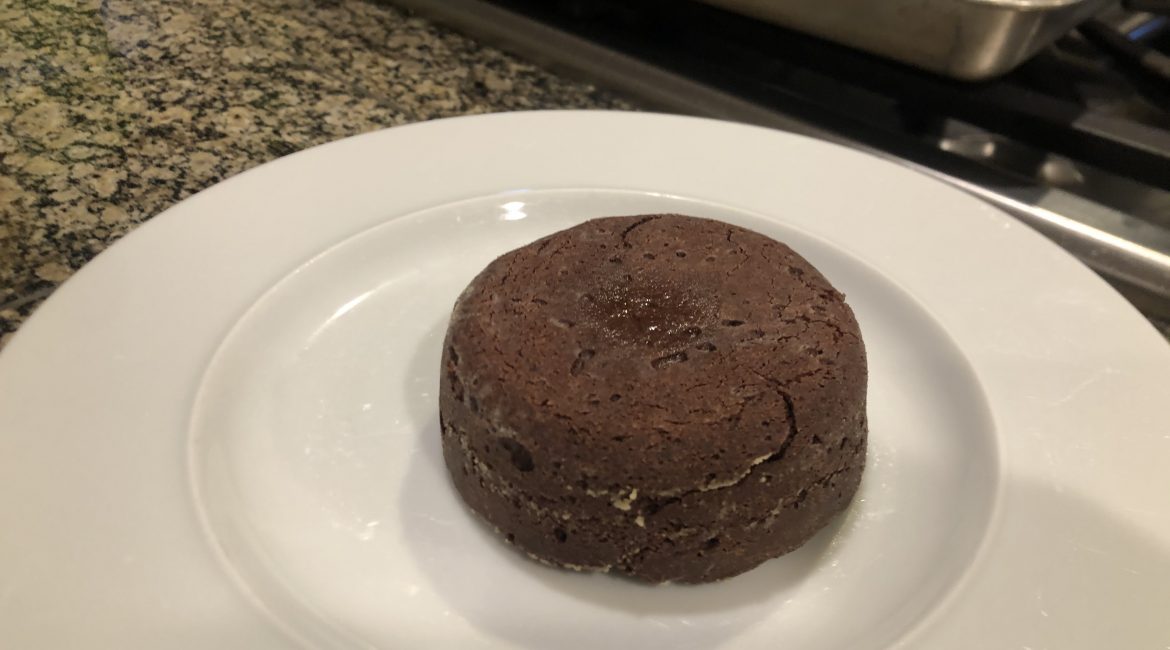Introduction:
A chocolate lava cake is known is for most like all other cakes, what makes it stand apart is the “molten” core where it gets the moniker of lava cake from. This cake is quick to make with only two steps that need to be done perfectly. Folding the chocolate and egg mix, and the cooking time.
Scientific Explanations:
Most steps in the process of creating the cake are fairly simple, applying butter and flour ramekins, melting chocolate and butter while whisking eggs and sugar together, then folding them together, then putting the batter in the ramekins and baking.
You need to butter and flour the ramekins to prevent the cake from sticking once its cooked. Without this the cake would stick due to the sugar in the chocolates caramelizing and sticking to the ramekins. The butter is used for a surface to stick the flour to, while the flour is what really stops the sticking. This happens because the flour acts as a barrier between batter and the ramekin. The whisking of the eggs, egg yolk, and sugar has two purposes, one to add air into the batter so when cake bakes the air will expand causing the cake to rise. Two the mixing the eggs causes them to create a foam which will later be used to stabilize the structure of the cake due to the lack of gluten. When folding the chocolate and flour into the egg mixture you have to be careful of the temperature of the chocolate. If you add the chocolate into the egg mixture while it is to hot you will cause the eggs to curdle. This is because the heat from the chocolate will cause the eggs to coagulate prematurely turning the liquid mixture to into a more solid like state. (O’Neil, 2020)
Adjustments:
With this recipe there are some changes that can be made that will affect the outcome of the cakes, such as changing the temperature of chocolate used when folding, changing the baking time of the cake, and varying the amount of flour used.
By changing the temperature of the chocolate when you fold it with the egg mixture will affect how the cake will bake. When changing the temperature it can be either to hot or to cold. To cold is 86 – 90 degrees Fahrenheit since at below here the chocolate will begin to solidify and lose its temper. The temperature where it is to hot is 140 degrees Fahrenheit and above. Tempering chocolate occurs between 90 and 115 degrees where 90 is the lower limits of when the chocolate can still be tempered up to 115. While the recommended is around 100 because this is the melting point of cacao butter in chocolate bars. (Earl) When folding together the eggs and chocolate you have to add the chocolate to the egg mixture, by doing so it will gradually raise the temperature of the eggs. Where as if you add the eggs to the chocolate it will quickly raise the eggs temperature. Since eggs do not coagulate until 160 degrees Fahrenheit you will be fine as long as your chocolate does not exceed the recommended temperature. The coagulation occurs due to the denaturation of egg proteins when the egg mixture is whisked mixing the eggs, sugar. and salt together. The whisking breaks the protein shapes opening up the protein strands. If the chocolate temperature is to hot it will cause the egg to coagulate prematurely causing the cake to be slightly “cooked” before it enters the oven, effecting the end texture. The coagulation occurs due to the high temperature of the chocolate, causing the egg proteins to form new bonds with their hydrophilic ends pointing in trapping moisture inside. This premature coagulation of proteins occurs due to the High temperature of the chocolate when it is added to the egg mixture. Normally coagulation will occur when the batter is in the oven baking since the chocolate temperature of 115 degrees Fahrenheit does not have enough heat to cause coagulation to occur.(Joachim 2015)
When baking the cake it is recommended to have it bake for between 10 and 12 minutes. 12 minutes being the max because the cake will end up dry on the outside and will no longer have a molten core in the center. While under 10 minutes the cake will not be baked all the way through. The main concept behind baking the cake is the conduction of heat moving through the food. Conduction is where heat is moves through the batter from the outside to he center cooking it. Because of this the longer the cake is in the oven the deeper in the cake will be cooked, but this also means that the outer layers will be drier and overcooked. (O’Neil 2020)The prime concept of the cake is to bake the cake where it is fully cooked but the core does not have enough time to change from a liquid to a solid. If you were to bake the cake longer than 12 minutes then the core will have received enough heat to have the proteins solidify their structures and become a solid. While baking under 10 minutes may result in a fully baked cake but a larger portion of the cake will be in a liquid state rather than a solid.
By increasing or decreasing the amount of flour the amount of gluten will also vary, causing the cakes end texture. Increasing the amount of flour will lead to a firmer and harder texture, while less flour will lead to a chewier sponge like texture. This is all because of Gluten. The gluten though not naturally in flour the gluten is formed from the giladin and glutenin proteins in flour that bond together to form gluten when mixed with the eggs in the batter. (Crosby, 2012) The purpose of gluten in the recipe is to add to the end texture of the cake, lower amounts of gluten will create a chewier sponge like texture, while high amounts of gluten will result in a hard textured product.
In summary by varying the temperature of the chocolate will prematurely coagulate the egg proteins affecting the texture of the cake. Changing baking time will affect the dryness and how much of the cake is in a liquid state. While varying the amount of flour will directly affect the amount of gluten in the cake affecting the texture.
Ingredients
Instructions
- Preheat Oven 450F.
-
Lightly butter and flour 4 6 ounce ramekins Tap out excess flour and set Ramekins on a baking sheet
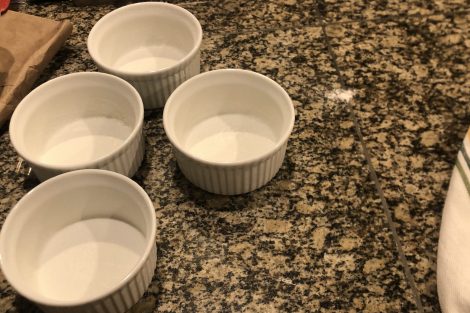
-
In a double boiler over simmering water, melt butter with chocolate in a medium bowl.
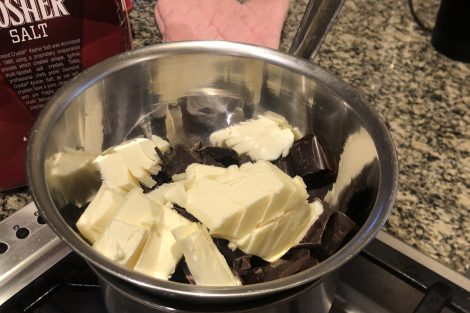
-
Whisk the chocolate and butter until they are smooth
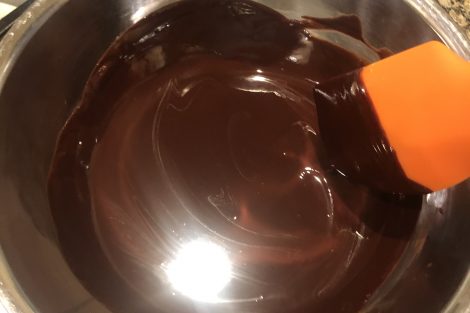
-
Beat the eggs, egg yolk, sugar, salt at high speed till thick and pale.
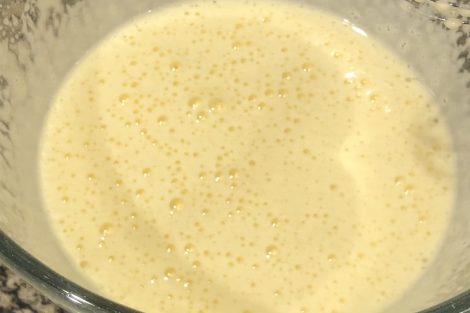
-
Quickly fold the chocolate into the egg mixture along with the flour. Making sure to keep the air within the batter.
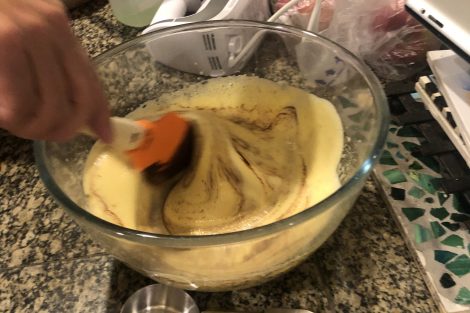
-
Spoon the batter into the ramekins and bake for 12 minutes. or until the sides of the cake are firm with a soft center.

-
Let cakes cool in the ramekins for 1 minute before covering each with an inverted desert plate. Carefully turn each one over and let stand for 10 seconds before removing the mold. Serve immediately.
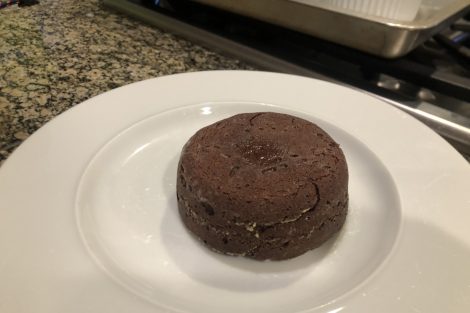
Notes
Images:
Nitta, G. (n.d.). Collection of Chocolate lava cake procedure. photograph, Seattle.
Other Sources:
O'Neil, C. (2020, May). Chemistry in the Kitchen Class. Chemistry in the Kitchen Class. CARLISLE.
Crosby, G. (2012). The science of good cooking: master 50 simple concepts to enjoy a lifetime of success in the kitchen. Brookline, MA: Americas Test Kitchen.
Joachim, D., & Schloss, A. (2015, February 25). The Science of Eggs - Article. Retrieved May 6, 2020, from https://www.finecooking.com/article/the-science-of-eggs
Earl, M. (n.d.). Tempering Chocolate with Perfect Temperature. Retrieved May 6, 2020, from https://blog.thermoworks.com/candy-chocolate/tempering-chocolate-perfect-temperature/
